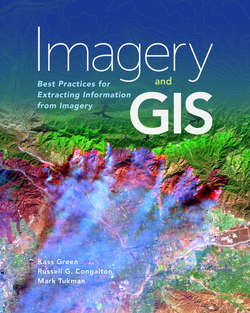Читать книгу Imagery and GIS - Kass Green - Страница 15
На сайте Литреса книга снята с продажи.
Rasters versus Vectors
ОглавлениеGIS data is stored as either rasters or vectors. Vectors represent the world with points, lines, or polygons. A point is one location represented by x, y, and z coordinates. A line is a linear connection between points. Sometimes lines are connected into a network of topologically connected lines. A polygon is a set of lines joined together to enclose an area. Polygons are drawn to outline the shape of an object of interest.
Rasters divide the landscape into a grid of equal-area rectangular cells. The rectangular shape of an individual cell does not represent a specific object on the ground. Rather, the cell is an arbitrary delineation. Lines or polygon shapes on the ground are represented by connected raster cells, as shown in figure 2.A.
Most imagery is collected as raster data, which is why most imagery is captured and stored as rasters. Because of the simple structure of rasters, raster spatial analysis is relatively uncomplicated. However, unlike vectors, rasters do not have meaningful boundaries. In a raster, a lake is a cluster of spatially adjacent cells classified as water. There is no way to analyze the lake as a singular object—it is merely a collection of connected water cells. In a vector system, a lake is a polygon object with a defined boundary, which also carries information about the other objects sharing its boundary. As a result, we can measure the size of the lake, analyze the wildlife habitat next to the lake, and measure the distances from the lake to cabins. Vector spatial analysis is usually more computationally intensive than raster analysis, but vectors also better represent the shapes of the world as they actually exist, with curves and straight lines. As a result, vector maps are more aesthetically pleasing. Fortunately, raster maps can be converted to vector maps and vice versa, which means that map users can thoughtfully choose which data structure will best meet their needs. However, conversion from raster to vector or vector to raster data introduces changes that can potentially create errors, and care must be taken when this process is performed.
Figure 2.A. Representation of points, lines, and polygons in vector and raster formats
